Animation as a New Intellectual Commons
Joon Yang Kim
Animation researcher
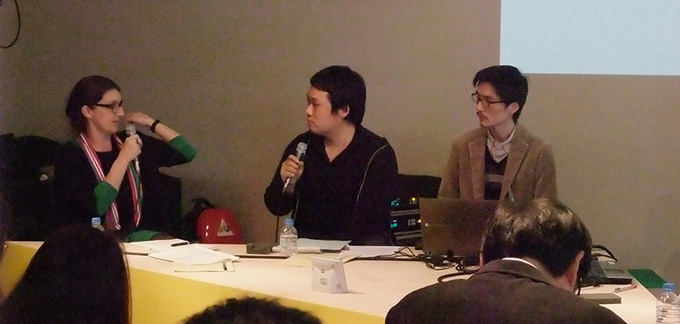
At the Media Arts Library Cafe talk session titled "Visualizing the Study of Manga/Animation," held at Roppongi Hills on February 17. (Left) Moderator Jacqueline Berndt, Professor of the Faculty of Manga and Head of Graduate School of Manga at Kyoto Seika University; (Center) Nobuaki Doi, Research Fellow at Japan Society for the Promotion of Science and Director at Japan Society for Animation Studies; (Right) The writer
On February 17, 2013, during the 16th Japan Media Arts Festival, a talk session titled "Visualizing the Study of Manga/Animation" took place as part of an event called the Media Arts Library Cafe at Roppongi Hills in Tokyo. In the session, the panelists reported on the results of their projects to map manga and animation studies undertaken both in Japan and overseas. I took part in the session as a member of the animation division.
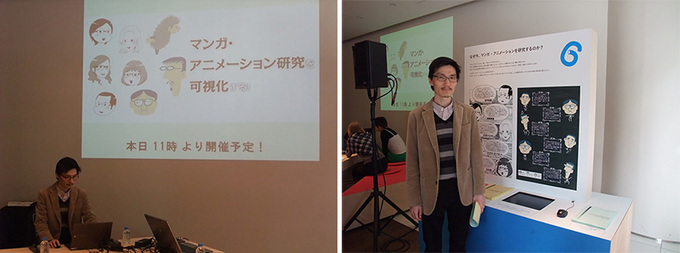
(Left) The writer taking the podium
(Right) At the talk session
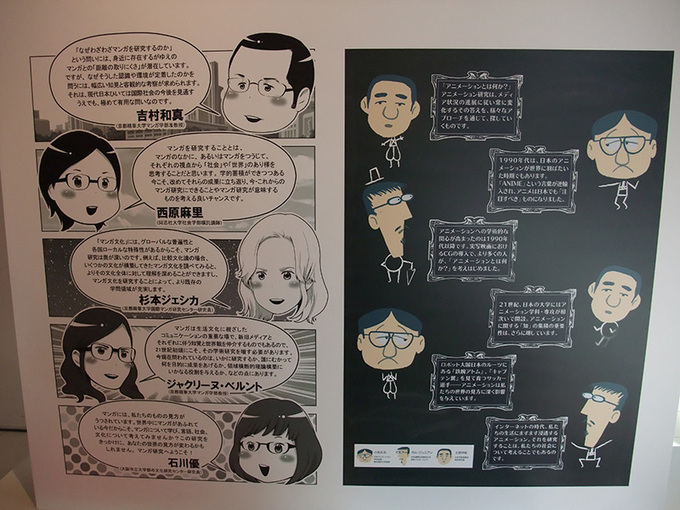
Illustrations exhibited at the talk session venue
The introduction of CG into live-action movies in the 1990s lies behind the growing academic interest in animation. Previously, movies had served as immovable records on film, but they have since become something that could be manipulated. This shift revealed a new connection between animation and movies. Since then, the links between CG and conventional animation have been studied actively, extending beyond film to the field of media studies. The Language of New Media (2001), written by Lev Manovich is one such example.
The word "media" has various meanings. To begin with, it is important to note that it is the plural form of the word "medium." This idea of pointing to the use of the plural form underlies, for example, the celebrated theory on visualization presented by John Berger in his Ways of Seeing (1972). The book is based on a BBC television program of the same name broadcast in the early 1970s. It is an excellent work that discusses the influence of various visual media, from Renaissance paintings to contemporary advertisements, on society.
Meanwhile, some factors that led to the rise of Japan's academic interest (as distinct from personal impressions or journalism) in animation was the reaction of the U.S. and Europe to Japanese popular culture, and their academic approach taken to its study. In the West, this took two forms: the first as area studies in the field of Asia or Japan studies; and the second as cultural studies which actively engaged in the study of popular cultures. Japan too was influenced by such movements, as can be seen, for example, in the special feature on "Japanimation" in the August 1996 issue of the magazine Eureka. Modern Japanese society tends to be conscious of how it is perceived by the West, and this mentality, I can say, also facilitated the burgeoning of Japan's academic interest in animation.
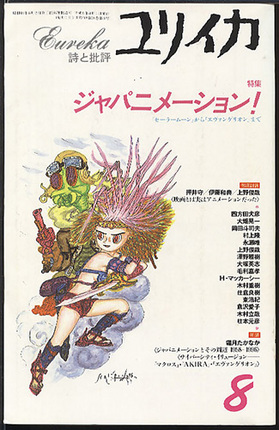
August 1996 issue of Eureka (Publisher: Seidosha) featuring "Japanimation"
Now you'll perhaps ask what animation studies is. They can be compared to film studies, which encompasses various approaches of looking at movies. As you can see, the use of the plural form as "studies" indicates that the subject cannot be summarized under a single principle. In English, words referring to research are often in the plural. Another example would be "physics," which in its contemporary meaning takes in various areas of physics that evolved in their own ways and gradually shaped the field of physic's', meaning various physical phenomena, as it was established in the mid-19th century (Michael J. Crowe, 2007). Likewise, animation is a simple word but expresses various phenomena that are extremely diverse, so it is not surprising that the methods of its study are varied.
One direction taken by animation studies is to accept the view that animation is already a culture enjoyed by society, and then to recognize that regardless of its position in the cultural hierarchy (or rather by emphasizing the power relationship hidden in the cultural hierarchy), advancing the studies will lead to the understanding of society or rather the world. The use of animation as a visual language is already widespread in live-action films, computer games, advertisements, digital device interfaces and various other media. Especially in Japan, many animated works have been produced and enjoyed in formats such as full-length films, TV series, and sell-through videos, and the culture is already deeply rooted in society. Many middle aged or older Japanese love Astro Boy (my topic of study), or any other robot or android animations, and conversation often turns lively as soon as the subject comes up. Taking into account that Japanese animation has been shown and sold both within Japan and overseas for dozens of years and is now seriously studied as a part of the culture, I believe that producing and transmitting ideas and information from within Japanese society (while of course being cautious of nativism) will more dynamically expand opportunities for the intellectual development.
(Original text written in Japanese)
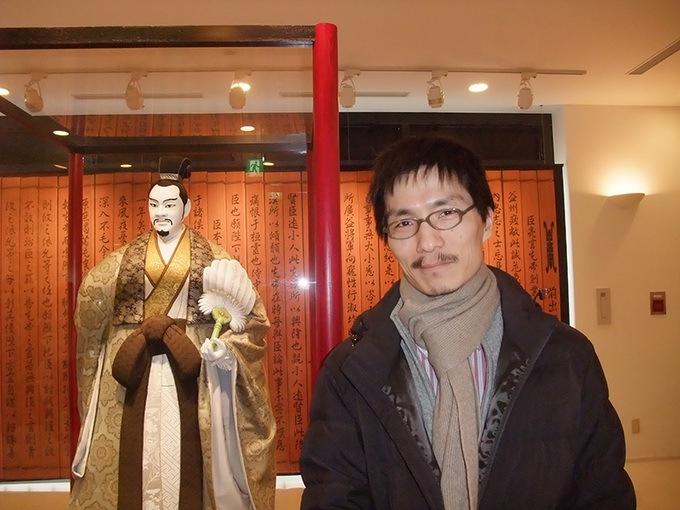
The writer visiting Kawamoto Kihachiro Puppet Museum in Iida City, Nagano Prefecture, in November 2012 to study Japanese puppets
Joon Yang Kim
Joon Yang Kim is animation researcher and critic, and teaches at the Korea National University of Arts. He specializes in engineering, aesthetics, philosophy, and Japanese studies. His book, Empire of Images: Animation on the Japanese Islands examines the meaning animation has had in Japanese society and modern history by analyzing and reviewing Japanese animation. The work was awarded the 1st Japan Foundation BORANABI Award for author/translator in 2008. He has contributed to Animation-no-Jiten (Encyclopedia of Animation; Asakura Publishing Co., Ltd.). Currently he is an Associate Editor for animation: an interdisciplinary journal, an academic magazine published by Sage in London. He also serves as a Director of the Japan Society for Animation Studies, the chief editor of the organization's bulletin and a Visiting Researcher at the Institute for Japanese Studies, Seoul National University.
He is a recipient of the Japan Foundation Japanese Studies Fellowship for fiscal year 2012, and currently studies at Tokyo Zokei University (till September 2013). His research theme is the "Ontology of the Mechanical-Human Depicted in Astro Boy in the Context of the Matter of Soul and Body in Philosophy and the Traditional Japanese Culture of Puppets."
Back Issues
- 2019.8. 6 Unraveling the Maker…
- 2018.8.30 Japanese Photography…
- 2017.6.19 Speaking of Soseki 1…
- 2017.4.12 Singing the Twilight…
- 2016.11. 1 Poetry? In Postwar J…
- 2016.7.29 The New Generation o…
- 2016.4.14 Pondering "Revitaliz…
- 2016.1.25 The Style of East As…
- 2015.9.30 Anime as (Particular…
- 2015.9. 1 The Return of a Chin…

